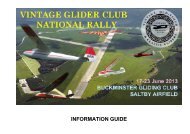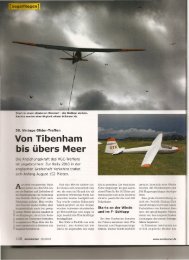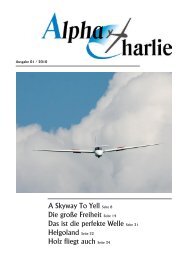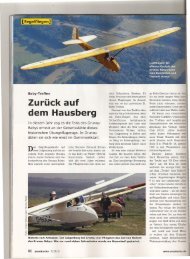Download - Vintage Glider Club
Download - Vintage Glider Club
Download - Vintage Glider Club
You also want an ePaper? Increase the reach of your titles
YUMPU automatically turns print PDFs into web optimized ePapers that Google loves.
Above: the Karpf-Zögling (Swiss primary)<br />
HB-473 has a partly covered steel-tube<br />
fuselage. Below: the AeCS-Zögling<br />
(primary) HB-429 with a wooden fuselage. Is<br />
the number on the rudder correct? Swiss<br />
federal archives / Thomas Fessler<br />
Right: AeCS-Zögling HB-429 of Thomas<br />
Fessler in the museum of history at<br />
Grenchen in 2003. Thomas Fessler<br />
Thomas, still in doubt went to the<br />
Swiss Federal Archives at Bern and asked<br />
for a look into the documents of the<br />
deleted Swiss gliders (including primaries).<br />
This is easier said than done! The<br />
complicated organisation system of the<br />
archives demands a lot of patience from<br />
their visitors and is extremely time-consuming.<br />
Thomas finally had the papers in hands<br />
and was even allowed do take photographs.<br />
He found out from the “register”<br />
that “his” primary HB-429 was given to<br />
Austria in 1950 and therefore had been<br />
deleted from the list. This is what the<br />
administration says - but who believes?<br />
USA<br />
from Bob Gaines dated 6. 12. 07.<br />
Bob is working on his PETREL, the<br />
second of the three Petrels that were<br />
built. He is trying to restore it in to the<br />
natural plywood and varnished finish that<br />
it had in 1939. So far the work is proceeding<br />
well but it is taking time. His<br />
RHOENBUSSARD, that was found by<br />
Johan Kruse in an Argentinean Café, is<br />
stored under dust covers, awaiting the finishing<br />
of the Petrel. It was one of several<br />
Rhoenbussards in Argentina.<br />
The US <strong>Vintage</strong> Gliding <strong>Club</strong>’s Magazine<br />
BUNGEE CORD has had a complete<br />
make-over and will have coloured<br />
pages. In the latest edition, there appears<br />
a “NEW ” looking RHOENBUSSARD.<br />
This was an old RHOENBUSSARD<br />
which has had every part built new. It<br />
originally came from Max Mueller at<br />
Muenster, Telgte. As it had short span<br />
ailerons in the Siebert style, the LBA<br />
could not consider it for a German C of<br />
A as it had no ‘Kennblatt’ with the short<br />
span ailerons. Thus, it was sold to Ted<br />
Hull at Dunstable who eventually<br />
changed the ailerons back to original<br />
style. Ted sold it on and finally, as no<br />
one would buy it, it was sold to a buyer<br />
in the USA. The “new” Rhoenbussard is<br />
to be on display at the 2008 SSA Convention.<br />
Construction should be finished<br />
for a first flight which is planned for the<br />
summer of 2008. Its builder, Mike Redman,<br />
found its construction complicated.<br />
The fuselage of the old Rhoenbussard is<br />
behind it in the photographs and seems<br />
to be still almost complete. Perhaps a<br />
second Rhoenbussard might appear as<br />
well? Mike Redman’s woodwork is<br />
absolutely first class. He had previously<br />
worked for RARE Aircraft in Minnesota<br />
with his father and two brothers. The<br />
firm restored antique aircraft.<br />
The ‘new look’ Vol 33 No 4, Winter<br />
2007 “BUNGEE CORD” magazine is<br />
superb with glossy pages and first class<br />
coloured photographs. This is the quarterly<br />
journal of the <strong>Vintage</strong> Soaring<br />
Association of America (the VSA). It<br />
mentions that there is currently a continuing<br />
project to translate Hans Jacobs<br />
famous Werkstattpraxis (Workshop Practice<br />
for <strong>Glider</strong>s and Sailplanes) into English,<br />
and is a combined American/Australian<br />
project. Work on the<br />
book is in its last stages with only the<br />
final proof reading, and inclusion of photos<br />
to be done. Bob Gaines and John<br />
Ashford are currently trying to source a<br />
publisher, and anyone with suggestions<br />
in this area, they would be keen to hear<br />
from. (All contacts can be made through<br />
the VSA itself at www.vintage<br />
sailplane.org).<br />
The Slingsby GULL 1, which was<br />
built in America, has been sent out to<br />
BUD BROWN by the National Soaring<br />
Museum in Lawrenceville, Illinois to be<br />
refurbished. Bud does nice work. It<br />
should be finished by the late summer of<br />
INTERNATIONAL NEWS<br />
2008. Most of the vintage <strong>Glider</strong> activity<br />
in the USA now appears to be centred<br />
on Lawrenceville and Tehapachi, California,<br />
although there is emerging activity<br />
in Wichita, Kansas (Neil Pfeifer) and<br />
Dansville, New York, not far from<br />
Elmira. In Lovettsville, on the Jan Scott<br />
Air Park, the collection is down to<br />
MOSWEY 3, the PRATT READ and<br />
BERGFALKE 2/55. Later aircraft are<br />
Ka-8, SF-27, Ka 14, an RF 5 motorglider,<br />
a 1-26 (not Linn’s…she sold hers<br />
last year) a Ka-7, a MISTRAL C and<br />
Jan’s Rotax FALKE.<br />
The HORTEN 3f and HORTEN V1 are<br />
now hanging in the UDVAR HAGY<br />
CENTRE (on DULLES AIRPORT). The<br />
two sweater HORTEN 3H centre section<br />
was never repaired, only preserved. The<br />
German restoration of the first two is very<br />
good but they can only be admired from a<br />
distance. As for the HORTEN 1X jet<br />
fighter (3rd prototype), as far as Jan Scott<br />
knows, it is pretty low down on the priority<br />
list of aircraft awaiting restoration.<br />
The HORTENS 3F and 3H were both<br />
located by Philip Wills in June 1945 in a<br />
wood in the French Zone. He had the<br />
Americans bring them in on their trailers,<br />
by the American 9th Disarmament Division<br />
at Nellingen near Stuttgart. They had<br />
been located on their trailers in a wood in<br />
the French Zone. The French had allowed<br />
their retrieval; they seemed both as new.<br />
With them was another unidentified 20m<br />
span Horten, which was not skinned.<br />
Philip Wills thought that he had organized<br />
them to be delivered to Farnborough but<br />
this did not happen as communications<br />
were then so bad between England and<br />
Germany. The HORTENS 3f and 3h,<br />
together with a HORTEN 2 and a<br />
HORTEN V1 were all taken to the USA<br />
where as far as we know they were delivered<br />
to the Northrop firm, which had its<br />
own flying wing programme. We believe<br />
that they were never flown in the USA<br />
but were allowed to deteriorate, alas. They<br />
were returned to Germany to Holge<br />
Steinle at the GERMAN TECHNICAL<br />
MUSEUM in BERLIN for restoration<br />
which took many years. New wings for<br />
the HORTEN 3f were quickly built. As<br />
this happened, we believe that the above<br />
museum may now have sets of new drawing<br />
plans for these aircraft. The HORTEN<br />
2 (ex-D-10-125) was restored and is now<br />
exhibited in the new German Technical<br />
Museum in Berlin.<br />
THE NEXT IVSM (International <strong>Vintage</strong><br />
Soaring Meet) is now to take place<br />
from June 27th until July 4th July,<br />
2009, at Harris Hill, one year earlier than<br />
was originally planned. ❏<br />
VGC News 123 Spring 2008 19







